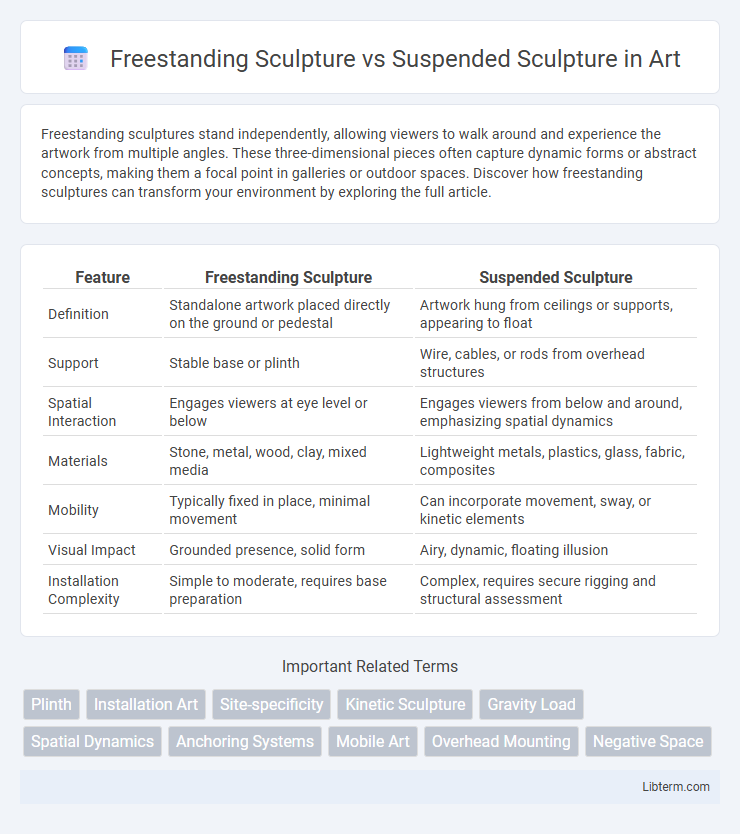Freestanding sculptures stand independently, allowing viewers to walk around and experience the artwork from multiple angles. These three-dimensional pieces often capture dynamic forms or abstract concepts, making them a focal point in galleries or outdoor spaces. Discover how freestanding sculptures can transform your environment by exploring the full article.
Table of Comparison
| Feature | Freestanding Sculpture | Suspended Sculpture |
|---|---|---|
| Definition | Standalone artwork placed directly on the ground or pedestal | Artwork hung from ceilings or supports, appearing to float |
| Support | Stable base or plinth | Wire, cables, or rods from overhead structures |
| Spatial Interaction | Engages viewers at eye level or below | Engages viewers from below and around, emphasizing spatial dynamics |
| Materials | Stone, metal, wood, clay, mixed media | Lightweight metals, plastics, glass, fabric, composites |
| Mobility | Typically fixed in place, minimal movement | Can incorporate movement, sway, or kinetic elements |
| Visual Impact | Grounded presence, solid form | Airy, dynamic, floating illusion |
| Installation Complexity | Simple to moderate, requires base preparation | Complex, requires secure rigging and structural assessment |
Introduction to Freestanding and Suspended Sculptures
Freestanding sculptures are three-dimensional artworks designed to be viewed from all sides, standing independently without support, such as Michelangelo's David or Rodin's The Thinker. Suspended sculptures, often called mobiles, are hung from ceilings or structures, creating dynamic movement and interaction with space and light, exemplified by Alexander Calder's kinetic art. Both forms emphasize different spatial relationships: freestanding sculptures engage physically with their surroundings, while suspended sculptures explore balance and motion in the air.
Defining Freestanding Sculpture: Key Characteristics
Freestanding sculpture is characterized by its ability to stand independently without support or attachment to other structures, showcasing a fully three-dimensional form that can be viewed from all angles. It often occupies physical space on a base or pedestal and is made from diverse materials such as bronze, marble, or wood. This type of sculpture emphasizes volume, mass, and contour, allowing for dynamic interaction with light and spatial context.
Understanding Suspended Sculpture: An Overview
Suspended sculptures create dynamic spatial interactions by hanging artwork from ceilings or structures, enabling movement and changing perspectives in response to environmental factors like air currents. Unlike freestanding sculptures, which rely on solid bases and physical grounding, suspended sculptures emphasize gravity, tension, and balance to achieve three-dimensional form and visual impact. Key materials include lightweight metals, wire, and fabric, allowing flexibility and fluidity in design, often found in contemporary art installations and architectural applications.
Historical Evolution of Both Sculpture Types
Freestanding sculptures have origins in ancient civilizations such as Egypt and Mesopotamia, where statues were crafted from stone and metal to represent deities or leaders in three-dimensional form accessible from all angles. Suspended sculptures emerged more prominently during the 20th century with modernist movements, inspired by kinetic art and innovations in materials like wire, fabric, and lightweight metals, allowing dynamic interaction within a space. The historical evolution reflects a shift from monumental permanence in freestanding works toward spatial experimentation and movement in suspended sculptures, illustrating changing artistic priorities and technological advancements.
Materials Commonly Used in Each Technique
Freestanding sculptures commonly utilize materials such as bronze, marble, wood, and steel due to their structural integrity and durability, allowing the artwork to stand independently. Suspended sculptures often employ lightweight materials like aluminum, acrylic, fabric, and wire to facilitate hanging and mobility while maintaining balance and stability. The choice of materials directly influences the sculpture's form, weight, and interaction with surrounding space in both techniques.
Spatial Interaction: Grounded vs. Hanging Artworks
Freestanding sculptures engage space through their grounded presence, inviting viewers to navigate around the artwork and experience it from multiple angles, enhancing three-dimensional interaction. Suspended sculptures create dynamic spatial effects by occupying overhead space, transforming the viewer's perception through movement, shadows, and changing perspectives as they hang above or within an environment. The contrasting spatial interactions emphasize the physical connection of freestanding works to the ground versus the ethereal, floating quality of suspended artworks, each shaping the viewer's experience of space uniquely.
Artistic Intent and Viewer Engagement
Freestanding sculptures emphasize artistic intent through dimensional presence and tactile interaction, inviting viewers to engage from multiple angles and physical proximities. Suspended sculptures convey motion and ethereal qualities, leveraging spatial dynamics to create immersive experiences that alter perception of gravity and space. Both forms foster distinct viewer engagements, with freestanding works emphasizing solidity and tangible form, while suspended works encourage exploration of lightness and floating abstraction.
Structural and Installation Considerations
Freestanding sculptures require a solid base and precise weight distribution to ensure stability and prevent toppling, often involving heavy materials like stone or metal. Suspended sculptures demand careful attention to load-bearing ceiling structures, secure anchoring points, and balanced design to avoid undue stress on suspension cables and building supports. Both types necessitate thorough engineering assessments and tailored installation strategies to maintain safety and preserve artistic integrity.
Notable Examples and Influential Artists
Notable freestanding sculptures include Michelangelo's "David," renowned for its intricate marble craftsmanship, and Auguste Rodin's "The Thinker," exemplifying expressive bronze artistry. Suspended sculptures gain prominence through Alexander Calder's mobiles, which revolutionized kinetic art by integrating movement and balance in suspended forms. Influential artists like Henry Moore also bridge both styles, creating monumental freestanding sculptures alongside innovative suspended works that explore space and viewer interaction.
Choosing Between Freestanding and Suspended Sculptures
Choosing between freestanding and suspended sculptures depends on factors such as spatial dynamics, weight distribution, and viewer interaction. Freestanding sculptures offer stability and tactile engagement, suitable for open spaces, while suspended sculptures create dynamic visual effects with movement and lightness, ideal for high-ceiling areas. Consider installation complexity and maintenance requirements to ensure optimal integration within the intended environment.
Freestanding Sculpture Infographic

 libterm.com
libterm.com